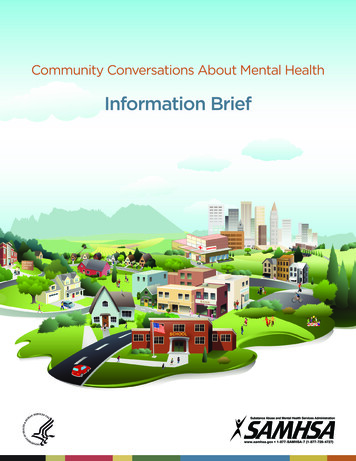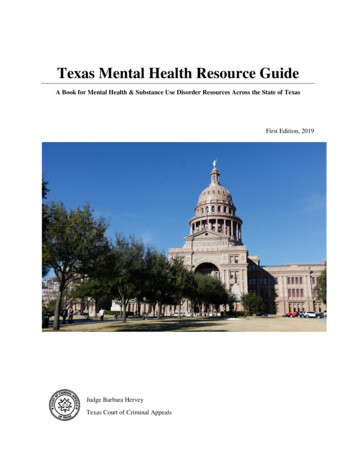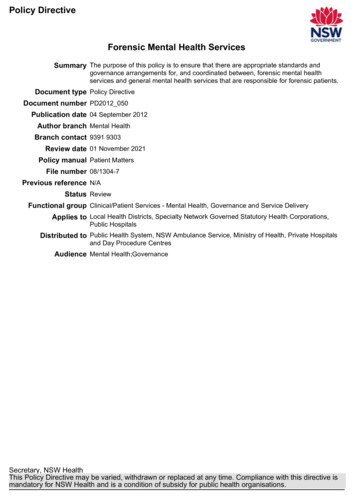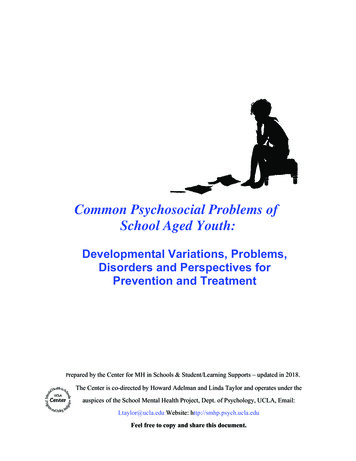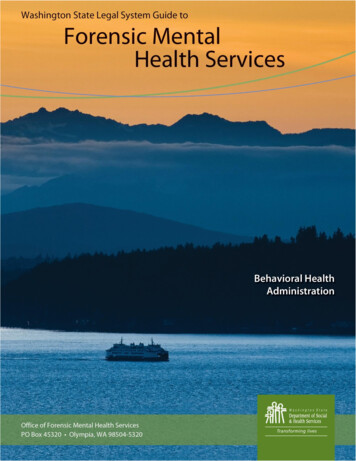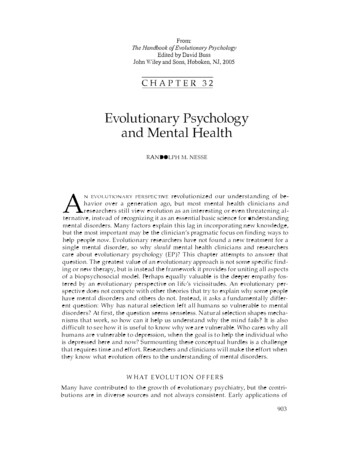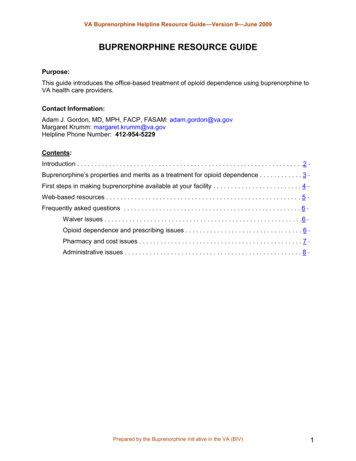
Transcription
VA Buprenorphine Helpline Resource Guide—Version 9—June 2009BUPRENORPHINE RESOURCE GUIDEPurpose:This guide introduces the office-based treatment of opioid dependence using buprenorphine toVA health care providers.Contact Information:Adam J. Gordon, MD, MPH, FACP, FASAM: adam.gordon@va.govMargaret Krumm: margaret.krumm@va.govHelpline Phone Number: 412-954-5229Contents:Introduction . . . . . . . . . . . . . . . . . . . . . . . . . . . . . . . . . . . . . . . . . . . . . . . . . . . . . . . . . . . . . . . .2 Buprenorphine’s properties and merits as a treatment for opioid dependence . . . . . . . . . . . . 3 First steps in making buprenorphine available at your facility . . . . . . . . . . . . . . . . . . . . . . . . . 4 Web-based resources . . . . . . . . . . . . . . . . . . . . . . . . . . . . . . . . . . . . . . . . . . . . . . . . . . . . . . . 5 Frequently asked questions . . . . . . . . . . . . . . . . . . . . . . . . . . . . . . . . . . . . . . . . . . . . . . . . . . 6 Waiver issues . . . . . . . . . . . . . . . . . . . . . . . . . . . . . . . . . . . . . . . . . . . . . . . . . . . . . . . .6 Opioid dependence and prescribing issues . . . . . . . . . . . . . . . . . . . . . . . . . . . . . . . . . 6 Pharmacy and cost issues . . . . . . . . . . . . . . . . . . . . . . . . . . . . . . . . . . . . . . . . . . . . . . 7 Administrative issues . . . . . . . . . . . . . . . . . . . . . . . . . . . . . . . . . . . . . . . . . . . . . . . . . . 8 Prepared by the Buprenorphine Init ative in the VA (BIV)1
VA Buprenorphine Helpline Resource Guide—Version 9—June 2009IntroductionThe problem of treatment for opioid dependence in the VAOpioid dependence is a chronic, relapsing medical disorder that afflicts several millionindividuals in the United States, including at least 30,200 veterans enrolled in the VeteransHealth Administration (VHA). Untreated or ineffectively treated opioid dependencesignificantly contributes to premature mortality and increased utilization of health care andsocial services. Furthermore, illicit opioid use contributes to increased use of alcohol and otherdrugs, criminal activity, and incidence of and morbidity from psychiatric and other medicaldisorders, including human immunodeficiency virus (HIV) and hepatitis C. In the VHA, as manyas 65% of veterans diagnosed with opioid dependence do not receive specialized care for it, andover a twelve-month period, only 21% of veterans with opioid dependence had six or more visitswith a VA opioid agonist therapy program (OATP) (e.g., methadone program).Efforts to solve the problemIn an effort to expand access to opioid agonist therapy beyond traditional opioid agonist therapyprograms, Congress made an amendment to the Drug Addiction Treatment Act (DATA 2000),signed in 2002, which allows qualified physicians to prescribe and dispense approvedbuprenorphine (Subutex) and buprenorphine/naloxone (Suboxone) sublingual tablets(hereafter collectively termed „buprenorphine‟) in office-based practices.Buprenorphine has been shown to be a safe and effective treatment of opioid dependence innon-specialized, outpatient, office-based settings, including VA environments. Furthermore,buprenorphine‟s availability has encouraged opioid-dependent patients who would nototherwise present themselves to an OATP to access treatment. In 2003, after an evidence-basedliterature review and consultation with topic experts, the VHA established non-formularyguidelines for buprenorphine use, and in 2006, formulary guidelines were established. Thispermitted the use of buprenorphine sublingual tablets for the treatment of opioid dependence inthe VA.Prepared by the Buprenorphine Initiative in the VA (BIV)2
VA Buprenorphine Helpline Resource Guide—Version 9—June 2009These are links to important VA information regarding buprenorphine use:VA Formulary Guidelines for Archive/criteria/Buprenorphine.pdfVA Buprenorphine Drug enorphineDrugMonograph.pdfVA Buprenorphine Pharmacy norphine’s properties and merits as a treatment for opioid dependence-- Buprenorphine is a partial opioid agonist. Since it is a partial agonist, it helps to treat opioiddependence by activating mu-opioid receptors enough to prevent withdrawal symptoms but notenough to induce a high (though it does so in opioid-naïve individuals).-- Buprenorphine has a ceiling effect, meaning that beyond a certain dose (generally consideredto be 32mg), no further effect is achieved. Thus, the risk of respiratory depression is lower thanfull agonists such as methadone, and an overdose is far less likely to have serious consequences.-- Buprenorphine has a higher affinity for the mu-opioid receptor than other opioids. If anotheropioid is taken concurrently, it will have no effect since buprenorphine blocks the receptor site.-- Buprenorphine has a half-life of 24 to 36 hours. This makes daily or every-other-day dosingpossible.-- Buprenorphine can be prescribed in an office setting on an outpatient basis just likemedications for any other chronic disease.TopPrepared by the Buprenorphine Initiative in the VA (BIV)3
VA Buprenorphine Helpline Resource Guide—Version 9—June 2009First steps in making buprenorphine available at your facilityExamine the VA web-based information (listed above). A common barrier is simply the lack ofknowledge at the administrative level that use of buprenorphine has been mandated in the VA,and these resources may be helpful in overcoming this.At least one prescribing physician needs to be waivered to provide buprenorphine (though it isgood for more than one to be waivered for back-up). Only physicians can prescribebuprenorphine. Before a physician may prescribe buprenorphine, he or she must meet eligibilityby being trained and then applying for a DEA waiver to prescribe buprenorphine. The trainingconsists of either a one-day, 8-hour training course approved by the Drug Addiction andTreatment Act of 2000 (DATA-2000) or an online version certified by the American PsychiatricAssociation, American Academy of Addiction Psychiatry, or the American Society of AddictionMedicine (ASAM). Physicians who hold board certification in addiction medicine from ASAM,the American Osteopathic Association, or in addiction psychiatry from the American Board ofMedical Specialties are exempt from the training course. A waiver to prescribe buprenorphinecan then be filed with the Center for Substance Abuse Treatment (CSAT) online, or via mail orfax. After a 45-day waiting period, the DEA will issue the prescribing physician a DEA numbergranting permission to initiate buprenorphine utilization. During the first year of holding thewaiver, a physician can prescribe buprenorphine to a maximum of 30 patients at any one time.One year after the date on which a physician submitted the initial notification, he or she maysubmit a second notification of the need and intent to treat up to 100 patients.Wherever buprenorphine is prescribed, non-pharmacologic treatments for addiction should beavailable and offered to patients who are considering buprenorphine. Unlike prescribingmethadone in OATPs, the only regulation in prescribing buprenorphine in an office-basedpractice is the one dictating the maximum number of patients being treated by a waiveredphysician at any given time.TopPrepared by the Buprenorphine Initiative in the VA (BIV)4
VA Buprenorphine Helpline Resource Guide—Version 9—June 2009Web-Based ResourcesBuprenorphine SAMHSA website:o http://www.buprenorphine.samhsa.gov/Buprenorphine Information:o http://www.csam-asam.org/resources-buprenorphine info.vp.htmlClinical Guidelines:o http://www.csam-asam.org/TIP40.vp.htmlPhysician & treatment program locator:o http://buprenorphine.samhsa.gov/bwns locator/index.htmlUpcoming trainings:o ine waiver to prescribe buprenorphine:o rint waiver to prescribe buprenorphine:o http://buprenorphine.samhsa.gov/howto.htmlMentors for physicians treating opioid dependence:o http://www.pcssmentor.org/American Academy of Addiction Psychiatry (AAAP):o http://www.aaap.orgAmerican Society of Addiction Medicine (ASAM):o http://www.asam.orgCenter for Substance Abuse Treatment (CSAT):o http://www.csat.samhsa.gov/The College on Problems of Drug Dependence:o http://www.cpdd.vcu.edu/The National Association of Alcoholism and Drug Abuse Counselors:o http://naadac.orgThe National Clearinghouse for Drug and Alcohol Information catalog:o http://www.health.org/catalog/catalog.htmNational Institute on Alcohol Abuse and Alcoholism (NIAAA):o http://www.niaaa.nih.gov/National Institute on Drug Abuse (NIDA):o http://www.nida.nih.gov/Office of National Drug Control Policy:o http://www.whitehousedrugpolicy.govTopPrepared by the Buprenorphine Initiative in the VA (BIV)5
VA Buprenorphine Helpline Resource Guide—Version 9—June 2009Frequently Asked Questions (FAQ)The following FAQ and responses have been reproduced from buprenorphine.samhsa.gov, otherweb-based resources, and best available evidence and expert opinions. Most of this informationis covered in the training course that allows providers to receive a waiver to prescribebuprenorphine.The questions are linked to their answers in this document.Waiver issues1. As a physician employed by the Federal Government (Veterans Administration, IndianHealth Service, Federal Department of Corrections, etc.) practicing in a FederalGovernment installation, am I eligible for a DATA 2000 waiver?2. Can physicians immediately treat patients if they have checked “Immediate” on thewaiver notification form?3. May buprenorphine ever be administered by a practitioner without the DATA 2000waiver?4. I submitted my waiver notification to SAMHSA a few weeks ago and received anacknowledgment letter, but I haven‟t heard anything since. How can I check on thestatus of my waiver?5. I've heard this new model for the treatment of opioid addiction referred to as "officebased opioid therapy." Does that mean that physicians with DATA 2000 waivers can usebuprenorphine to treat opioid addiction only in an office-based setting?6. With a DATA 2000 waiver, can I prescribe buprenorphine for opioid addiction in morethan one practice location? Can I dispense it from more than one location?7. I am a waived physician, and I've moved my practice location since receiving my waiver.Do I need to notify SAMHSA or DEA of my new practice address?8. I am a waived physician and would like to add, change, or remove my listing on theSAMHSA Buprenorphine Physician Locator Web site. How do I do this?TopOpioid dependence and prescribing issues1. How is opioid dependence diagnosed?2. What is the clinical use of buprenorphine for opioid addiction therapy?3. How is buprenorphine different from the current treatment options for opioiddependence such as methadone?4. Can a person currently being treated with methadone switch to buprenorphine withoutsuffering withdrawal symptoms?Prepared by the Buprenorphine Initiative in the VA (BIV)6
VA Buprenorphine Helpline Resource Guide—Version 9—June 20095. Do you follow the same rules for dispensing buprenorphine as you would for dispensingmethadone through a methadone clinic (e.g. labeling, take home doses)?6. What are the side effects of buprenorphine?7. Is it feasible to treat homeless opioid dependent patients with buprenorphine?8. Is buprenorphine safe for use during pregnancy?9. Is buprenorphine safe for use with breastfeeding mothers?10. Is it safe to drive or operate machinery while on buprenorphine?11. Is it required that a patient fail a trial of methadone prior to being prescribedbuprenorphine?12. If a patient has been on greater than 60mg of methadone at any time in the past, do youconsider that to be a contraindication for buprenorphine induction?13. Is it acceptable to start patients on buprenorphine while they are inpatients?14. What are the guidelines for continuing buprenorphine treatment on patients who areusing illicit drugs (e.g. marijuana)?15. Is use of benzodiazepines a contraindication to buprenorphine treatment?16. Should a patient be experiencing withdrawal symptoms when starting the inductionphase of buprenorphine?17. Is it acceptable to induce patients who are not in current withdrawal?18. How long do patients stay on buprenorphine?19. Are SARRTPs allowing patients taking buprenorphine to stay in the domiciliary?20. I practice both in the VA and outside of it. Do my VA patients count toward my patientlimit?Pharmacy and cost issues1. Do pharmacies need waivers to dispense buprenorphine?2. Is buprenorphine available in pharmacies?3. How much will a dose of buprenorphine cost a consumer?4. Will buprenorphine be available in treatment programs for indigent patients andpatients who don't have Medicaid or Medicare?Prepared by the Buprenorphine Initiative in the VA (BIV)7
VA Buprenorphine Helpline Resource Guide—Version 9—June 2009Administrative issues1. What job description should be used in describing the physician and non-physicianpositions that were funded under the buprenorphine initiative?2. Are there specific federal record-keeping requirements for office-based opioid therapy?3. Can an opioid treatment program (i.e., methadone clinic) dispense buprenorphine topatients admitted to the program? If so, is there a limit on the number of patients whocan be treated with buprenorphine for opioid addiction treatment in an OTP? Is a DATA2000 waiver required?4. Are providers with an X-number required to keep a copy of their license in thepharmacy?5. Is there a specific stop code for providing buprenorphine treatment?6. How do physicians obtain buprenorphine for patients‟ induction?7. Are patients able to take home supplies of these medicines?8. Does DATA 2000 limit the number of patients who may be treated for opioid addictionat any one time by a physician group practice?9. Is there a limit on the number of patients a practitioner may treat with buprenorphine atany one time?10. What should be done when a clinic wants to keep buprenorphine on site?11. Can physicians and other authorized hospital staff administer buprenorphine to apatient who is addicted to opioids but who is admitted to a hospital for a condition otherthan opioid addiction?12. Can physician assistants or nurse practitioners prescribe buprenorphine for opioidaddiction treatment in states that permit them to prescribe schedule III, IV, or Vmedications?13. What can physician assistants and nurse practioners do?14. May physicians in residency training programs obtain DATA waivers?15. Should our facility implement maintenance instead of detoxification with buprenorphineor both programs?16. How do you get patients?17. What type of clinical work-up do you do prior to admission to the program?18. Is there a special group therapy guide for this population?Prepared by the Buprenorphine Initiative in the VA (BIV)8
VA Buprenorphine Helpline Resource Guide—Version 9—June 200919. Can the medical personnel in correctional facilities dispense (or administer)buprenorphine to incarcerated individuals?TopWAIVER ISSUES1. As a physician employed by the Federal Government (VeteransAdministration, Indian Health Service, Federal Department of Corrections,etc.) practicing in a Federal Government installation, am I eligible for aDATA 2000 waiver?Yes. Physicians employed by an agency of the Federal Government are eligible for DATA2000 waivers. In order to be eligible for a waiver under DATA 2000, a physician musthave a valid, individually assigned DEA registration number (in addition to a license topractice medicine and the credentialing/training discussed elsewhere). A physician whois directly employed by the Federal Government may obtain a DEA number free ofcharge without being licensed in the state where the Federal facility is located (thephysician must have a valid state license in one of the 50 states, the District of Columbia,Virgin Islands or Puerto Rico). In order to receive a DEA number under this program,each physician must complete a DEA registration application that includes thephysician's official business address and the name and phone number of the certifyingofficial who can verify the physicians' eligibility for this program. This DEA registrationnumber may only be used for practice within the Federal Government installation andmay not be used for practice outside this setting. (Return)2. Can physicians immediately treat patients if they have checked “Immediate”on the waiver notification form?A place to check “Immediate” is included on the form to address a provision in the DrugAddiction Treatment Act to permit treatment while a notification is under review.Checking “Immediate” is one of the three requirements that a physician must meet inorder to start a patient on treatment, and treatment is limited to ONE patient per formsubmitted. (Each form must have a different submission date.) The three requirementsare: 1) the physician must “in good faith” meet the criteria for obtaining a waiver (i.e.,valid medical license, valid DEA registration, credentialing, or 8 hours of qualifyingtraining), 2) the physician must check “Immediate” on the waiver, and 3) the physicianmust contact the Buprenorphine Information Center at 1-866-BUP-CSAT to verify thatthe notification form has been received and to notify CSAT of his/her intent to begintreating ONE patient.Since the physician will not have the unique identifying number, pharmacists mayquestion prescriptions received under this provision and contact the BuprenorphineInformation Center if additional information is needed. (Return)3. May buprenorphine ever be administered by a practitioner without theDATA 2000 waiver?Under the Narcotic Addiction Treatment Act of 1974, all practitioners who use narcoticdrugs for treating opiate addiction must obtain a separate registration under 21 U.S.C.Prepared by the Buprenorphine Initiative in the VA (BIV)9
VA Buprenorphine Helpline Resource Guide—Version 9—June 2009Section 823(g)(1) or a DATA 2000 Waiver under 21 U.S.C. Section 823(g)(2). However,according to the Drug Enforcement Administration (DEA), an exception to theregistration requirement known as the "three-day rule" (Title 21, Code of FederalRegulations, Part 1306.07(b)) allows a practitioner who is not separately registered as anarcotic treatment provider or certified as a “waivered DATA 2000 physician” toadminister (but not prescribe) narcotic drugs to a patient for the purpose of relievingacute withdrawal symptoms while arranging for the patient‟s referral for treatmentunder the following conditions: 1) not more than one day‟s medication may beadministered or given to a patient at one time, 2) this treatment may not be carried outfor more than 72 hours, and 3) this 72-hour period cannot be renewed or extended.The intent of 21 CFR 1306.07(b) is to provide practitioner flexibility in emergencysituations where he or she may be confronted with a patient undergoing withdrawal. Insuch emergencies, it is impractical to require practitioners to obtain a separateregistration. The 72-hour exception offers an opioid-dependent individual relief fromexperiencing acute withdrawal symptoms, while the physician arranges placement in amaintenance/detoxification treatment program. This provision was established toaugment, not to circumvent, the separate registration requirement. The three-dayemergency exception cannot be renewed or extended. For further details, consult DEA m. (Return)4. I submitted my waiver notification to SAMHSA a few weeks ago and receivedan acknowledgment letter, but I haven’t heard anything since. How can Icheck on the status of my waiver?If you have submitted a notification and received an acknowledgment letter (or e-mail)from SAMHSA, then your notification is under active review. It is SAMHSA‟s intent tocomplete the review of notifications within 45 days of receipt. When processing of yournotification is complete, they will mail you a letter confirming your waiver andcontaining your prescribing identification number.If you have submitted a notification and received an acknowledgment from SAMHSAand it has been more than 2 months since you submitted your notification, or if yousubmitted a notification and you did not receive an acknowledgment that it had beenreceived, please call 1-866-BUP-CSAT (1-866-287-2728) or e-mailinfo@buprenorphine.samhsa.gov. Please be prepared to provide the date when yousubmitted your original notification and other identifying information. (Return)5. I've heard this new model for the treatment of opioid addiction referred toas "office-based opioid therapy." Does that mean that physicians with DATA2000 waivers can use buprenorphine to treat opioid addiction only in anoffice setting?No. Treatment of opioid addiction under the authority of a DATA 2000 waiver is notconfined to the office setting. Physicians with DATA 2000 waivers may treat opioidaddiction with buprenorphine in any practice settings in which they are otherwisecredentialed to practice and in which such treatment would be medically appropriate(e.g., office, community hospital). (Return)6. With a DATA 2000 waiver, can I prescribe buprenorphine for opioidaddiction in more than one practice location? Can I dispense it from morePrepared by the Buprenorphine Initiative in the VA (BIV)10
VA Buprenorphine Helpline Resource Guide—Version 9—June 2009than one location?Physicians with DATA 2000 waivers may prescribe buprenorphine for opioid addictionin any appropriate practice setting in which they are otherwise credentialed to practice(e.g., office, hospital). However, they may store and dispense buprenorphine (or anyother controlled substances) only at the practice address or addresses that they haveregistered with the DEA. Only one DATA-waiver unique identification number will beissued for each DATA-waived physician, no matter how many practice locations or DEAregistrations a physician may have.Additionally, a physician may have a total of 30 (or 100) patients on buprenorphineunder his or her care, not 30 or 100 at each practice location. (Return)7. I am a waived physician, and I've moved my practice location since receivingmy waiver. Do I need to notify SAMHSA or DEA of my new practice address?Waived physicians who change the primary practice address at which they intend to treatopioid addiction under the authority of their DATA 2000 waiver must notify SAMHSAby calling 1-866-BUP-CSAT (1-866-287-2728) or via e-mail atinfo@buprenorphine.samhsa.gov. The Drug Enforcement Administration must also benotified. Call the DEA Office of Diversion Control at 1-800-882-9539. Phone numbersfor local DEA offices can be found on the DEA Web site at http://www.dea.gov. (Return)8. I am a waived physician and would like to add, change, or remove my listingon the SAMHSA Buprenorphine Physician Locator Web site. How do I dothis?Waived physicians may call 1-866-BUP-CSAT (1-866-287-2728) or e-mailinfo@buprenorphine.samhsa.gov with requests to change locator listings. (Return)OPIOID DEPENDENCE AND PRESCRIBING ISSUES1. How is opioid dependence diagnosed?A diagnosis of opioid dependence is based on the DSM-IV Criteria for Substance-RelatedDisorders. According to these criteria, a person is considered opioid-dependent when heor she manifests 3 or more of the following within a 12-month period:Tolerance (defined as a need for substantially greater amounts of an opioid toachieve the desired effect or a substantially reduced effect with continued use ofthe same amount of the opioid).Withdrawal (which, for opioid dependence, is characterized by certain symptomsthat appear when heavy or prolonged use of the opioid ceases or when an opioidantagonist is taken after a period of opioid use).Frequent use of larger amounts of the opioid than planned or use of it over alonger period of time than planned.Persistent desire to cut down or control use of the opioid or trying unsuccessfullyto do so .Devotion of a great deal of time toward obtaining the opioid, using it, orrecovering from its effects.Prepared by the Buprenorphine Initiative in the VA (BIV)11
VA Buprenorphine Helpline Resource Guide—Version 9—June 2009Surrendering or reduction of important social, occupational, or recreationalactivities because of the use of the opioid.Continued use of the opioid despite knowing that one has a persistent orrecurrent physical or psychological problem probably caused or made worse bythe opioid. (Return)2. What is the clinical use of buprenorphine for opioid addiction therapy?Ideal candidates for opioid addiction treatment with buprenorphine are individuals whohave been objectively diagnosed with opioid addiction, are willing to follow safetyprecautions for treatment, can be expected to comply with the treatment, have nocontraindications to buprenorphine therapy, and who agree to buprenorphine treatmentafter a review of treatment options.There are three phases of buprenorphine maintenance therapy: induction, stabilization,and maintenance.The induction phase is the medically monitored start-up of buprenorphine therapy.Buprenorphine for induction therapy is administered when an opioid-addictedindividual has abstained from using opioids for 12–24 hours and is in the early stages ofopioid withdrawal. If the patient is not in the early stages of withdrawal (i.e., if he or shehas other opioids in the bloodstream), then the buprenorphine dose could precipitateacute withdrawal. Induction is typically initiated as observed therapy in the physician‟soffice.The stabilization phase has begun when a patient has discontinued or greatlyreduced the use of his or her drug of abuse, no longer has cravings, and is experiencingfew or no side effects. The buprenorphine dose may need to be adjusted during thestabilization phase. Because of the long half-life of buprenorphine, it is sometimespossible to switch patients to alternate-day dosing once stabilization has been achieved.The maintenance phase is reached when the patient is doing well on a steady dose ofbuprenorphine. The length of the maintenance phase is different for each patient and infact may be indefinite.If both doctor and patient agree that buprenorphine treatment may be ceased, then thedose is gradually tapered until the phase called medically supervised withdrawal.This takes the place of what was formerly called “detoxification.” (Return)3. How is buprenorphine different from the current treatment options foropioid dependence such as methadone?Currently, opiate dependence treatments like methadone can be dispensed only in alimited number of clinics that specialize in addiction treatment. There are not enoughaddiction treatment centers to help all patients seeking treatment. Buprenorphine is thefirst narcotic drug available under the Drug Abuse Treatment Act (DATA) of 2000 thatcan be prescribed in a doctor‟s office for the treatment of opioid dependence. Thisprovides more patients the opportunity to access treatment. (Return)4. Can a person currently being treated with methadone switch tobuprenorphine without suffering withdrawal symptoms?Prepared by the Buprenorphine Initiative in the VA (BIV)12
VA Buprenorphine Helpline Resource Guide—Version 9—June 2009Patients can switch from methadone to buprenorphine treatment, but because the twodrugs are very different, patients are not always satisfied with the results. A number offactors affect whether buprenorphine is a good choice for someone who is currentlyreceiving methadone.It is also possible for patients receiving buprenorphine to be switched to methadone.Patients interested in finding out more about the possibility of switching treatmentshould discuss this with their prescribing physician. (Return)5. Do you follow the same rules for dispensing buprenorphine as you wouldfor dispensing methadone through a methadone clinic (e.g. labeling, takehome doses)?Yes, but only when used in a methadone program; it requires the same dosingschedule/take homes. When outside of a methadone program, it is prescribed just likeany other medication without special regulations. (Return)6. What are the side effects of buprenorphine?(This is NOT a complete list of side effects reported with buprenorphine. Please refer tothe package insert for a complete list of side effects.)The most common reported side effects include:cold or flu-like symptomssleeping difficultiesheadachesnauseasweatingmood swingsLike other opioids, buprenorphine has been associated with respiratory depression,especially when combined with other depressants. (Return)7. Is it feasible to treat patients who are homeless with buprenorphine?Yes. This is the conclusion from a pertinent study:“Despite homeless opioid dependent patients' social instability, greatercomorbidities, and more chronic drug use, office-based opioid treatment withbuprenorphine was effectively implemented in this population comparable tooutcomes in housed patients with respect to treatment failure, illicit opioid use,and utilization of substance abuse treatment.”Alford, DP, et al. Treating Homeless Opioid Dependent Patients with Buprenorphine inan Office-Based Setting. J Gen Intern Med. 2007 Feb;22(2):171-176. (Return)8. Is buprenorphine safe for use during pregnancy?Buprenorphine is classified as Pregnancy Category C. There are no adequate and wellcontrolled studies of buprenorphine in pregnant women. Naloxone is stronglycontraindicated as it can cause seizures in the newborn infant, so the buprenorphinemonotherapy (Subutex) is preferred if the mother is unable or unwilling to switch tomethadone for the duration of the pregnancy. (Return)Prepared by the Buprenorphine Initiative in the VA (BIV)13
VA Buprenorphine Helpline Resource Guide—Version 9—June 20099.
Health Service, Federal Department of Corrections, etc.) practicing in a Federal Government installation, am I eligible for a DATA 2000 waiver? 2. Can physicians immediately treat patients if they have checked “Immediate” on the waiver notification form? 3. May buprenorphine ever be


